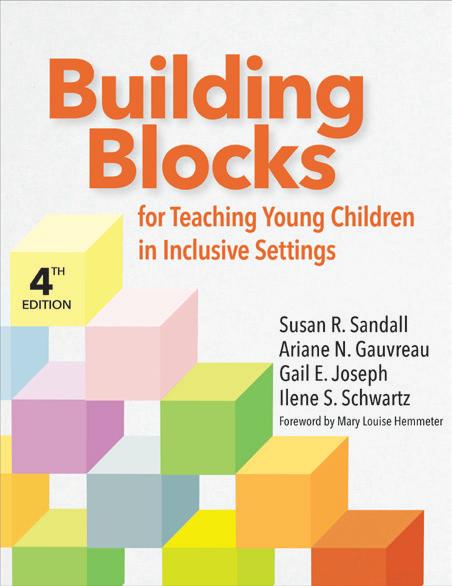

TEXT BOOKS
EARLY CHILDHOOD

NEW AND BESTSELLING TEXTS FOR YOUR COURSES!

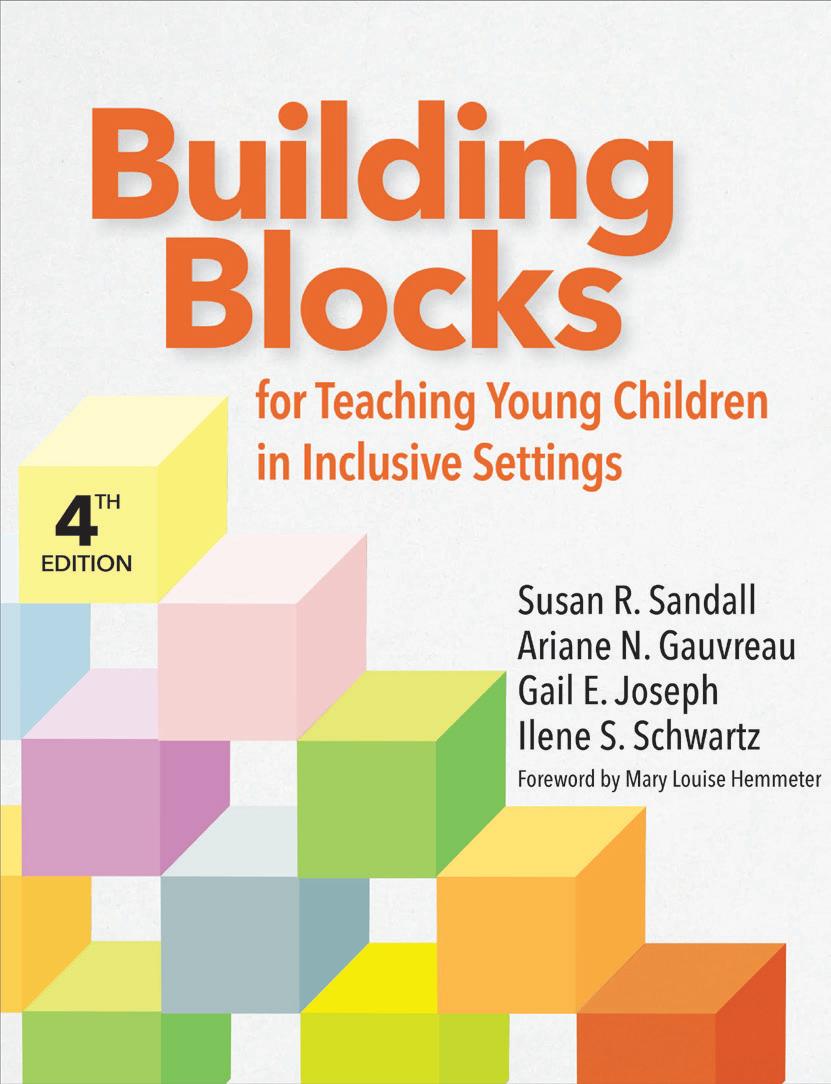



EARLY CHILDHOOD

NEW AND BESTSELLING TEXTS FOR YOUR COURSES!


I. USING THE BUILDING BLOCKS FRAMEWORK
1. Introduction
2. Evidence-Based Practice and the Building Blocks Framework
3. Keys to Teaming and Collaboration
4. Getting Started
II. TEACHING STRATEGIES
5. Curriculum Modifications
6. Embedded Learning Opportunities
7. Child-Focused Instructional Strategies
8. Ongoing Assessment and Instructional DecisionMaking (NEW)
III. MORE ABOUT THE BUILDING BLOCKS FRAMEWORK
9. Implementing the Building Blocks Framework: Putting it all Together
12.
Prepare early childhood educators to teach all children in inclusive settings with the fourth edition of this bestselling textbook—enhanced with new content, new topics, and more tools for planning effective instruction.
Like the groundbreaking previous editions, this updated Building Blocks guide gives preservice teachers three types of practical, evidence-based inclusion strategies: curriculum modifications, embedded learning opportunities, and child-focused instructional strategies. Future educators will learn how to apply these three strategies for the benefit of all children; review the latest research that supports the Building Blocks model; and find tips and guidance on key topics, from fostering friendships to promoting positive behavior. New reproducible forms support planning and assessment, and seven training modules make it easy to teach the Building Blocks framework in college courses.
• All chapters updated
• New chapter on Ongoing Assessment and Instructional DecisionMaking
• New chapter on Implementing the Building Blocks Framework
• 8 new checklists and planning forms to support implementation
• New section on the impact of implicit bias on teachers’ perception of challenging behavior
• Expanded content on key topics such as collaboration, curriculum modifications, friendships and social relationships
• Updated vignettes, terms, resources, and references
WITH 7 TRAINING MODULES: Using the Building Blocks framework
| Conducting ongoing child assessment | Planning for the individual child | Using visuals to support learning | Applying the Building Blocks framework to math and science | Applying the framework to challenging classroom behavior | Extending the framework to infants and toddlers

How can the next generation of educators close opportunity gaps for young children affected by poverty and systemic racism—and build hope and resilience for children and families? Research points the way forward, and in this timely volume, 40+ leading researchers identify new approaches, insights, and technologies that can promote educational equity and improve outcomes for children and families living in poverty.
Building on the seminal work of researcher John Fantuzzo, this text focuses on identifying and expanding on child, family, and community strengths to address the urgent needs of the whole child and the whole family. The expert contributors examine the importance of 1) child-level strengths and social connections, 2) strengths-based intervention as an antidote to deficit framing, and 3) collaboration and data sharing across systems serving vulnerable children and families.
CHAPTERS COVER RESEARCH AND RECOMMENDATIONS FOR:
• implementing interventions that foster children’s social-emotional learning skills
• developing culturally and linguistically valid tools for measuring social-emotional development
• creating more culturally inclusive preschool classrooms and practices
• enhancing young children’s communication and language competence in home visiting programs
• using partnership-based approaches to strengthen understanding between home and school
• integrating data across programs and agencies to inform early childhood policy and better address complex social issues
A foundational volume to prepare tomorrow’s early childhood researchers, administrators, and policy makers, this forward-thinking text will light the path toward greater educational equity, reduced disparities, and better outcomes for children and families.
US$89.95 | Stock #: 57464 | March 2024 | approx. 336 pages | 7 x 10 | paperback | ISBN 978-1-68125-746-4

I. INTRODUCTION
1. Real, Ready, and Responsible Research for Change
II. SOCIAL CONNECTIONS FOR CHILDREN’S WELL-BEING
2. Validation of Early Childhood Measures of SocialEmotional Competence for Linguistically and Ethnically Diverse Preschoolers
3. Capturing Socialization Experiences for Culturally Diverse, Low-Income Preschool Children
4. Bridging Divides and Making Visible the Invisible: Connecting Parents, Children, and Teachers Through Cultural Inclusion
III. STRENGTHS-BASED INTERVENTIONS ACROSS FAMILIES AND SETTINGS
5. Fostering Young Children’s Language Development Through Strategic Partnering
6. Developing Interventions That Foster Children’s Social-Emotional Development by Making Connections With Teachers, Families, and Schools
7. Conquering Kindergarten: Development and Initial Implementation of a Practical, Responsive, and Sustainable Teacher–Family Support System to Foster Children’s Social-Emotional Learning Skills
IV. PEOPLE, PROCESS, AND POLICY: DATA INTEGRATION FOR SYSTEMS CHANGE
8. Using Integrated Data to Better Understand and Address Complex Social Problems Facing Young Children and Their Families
9. Iowa’s Integrated Data System for DecisionMaking
10. Partnering for School Readiness: Integrating Data for Effectiveness Across Systems (IDEAS) Consortium for Children


1. Introduction to Models of Professional Collaboration
2. Agreements for Coaching Services: Establishing Ground Rules for Coaching
3. Building Rapport in a Coaching Relationship
4. Observation and Information Gathering
5. Implementing the Plan
6. Evaluating the Success of the Coaching Plan and the Partnership
7. Behind the Scenes in the Coaching Model
8. Coaching and Consultation in a Virtual World
By Laurie A. Dinnebeil, Ph.D. (University of Toledo), & William F. McInerny, Ph.D. (University of Toledo)Coaching is one of the best ways to enhance the skills of early childhood practitioners and ensure high-quality learning experiences for young children with and without disabilities. With this authoritative text, future educators and early interventionists will learn how to use coaching and consultation methods to support inclusion and improve outcomes for all children from birth to five.
Written by two experts on early childhood intervention and special education, this book introduces multiple models of professional collaboration and offers in-depth guidance on how to implement an effective consultation/coaching model in early childhood settings. From big-picture considerations to small logistical details, tomorrow’s professionals will master the entire process of creating, maintaining, and evaluating a successful coaching relationship. In each chapter, case examples, discussion questions, chapter summaries, and group activities reinforce key points and encourage reflection.
An ideal textbook for courses on consultation and coaching, this comprehensive guide will help early childhood practitioners work together to enhance educational and developmental outcomes for all young children.
• establish ground rules and objectives for coaching
• build rapport and strong communication skills within a coaching relationship
• systematically gather information about the child, teacher, and learning environment to inform coaching practices
• work together to set and prioritize intervention goals for children
• create and implement an action plan that addresses intervention goals
• deliver effective performance feedback
• evaluate the success of both the coaching plan and the partnership
• use current technology to harness the benefits of tele-intervention, mobile coaching, and remote consultation
PRACTICAL MATERIALS: Support successful coaching and consultation with more than 25 reproducible downloads, including data collection forms, action plans, a planning matrix, self-assessments, and coaching session sample logs.

(LDS Consulting)
Meaningful, authentic assessment practices are one key to the success of early childhood inclusion. Prepare future teachers with the second edition of this comprehensive textbook, an in-depth guide to the how and the why of high-quality assessment in the context of inclusive early childhood settings.
Updated with new contributors and coverage of timely new topics, this book takes a blended approach to assessment, combining the latest recommended practices from early childhood education and early childhood special education. Well-known experts Kristie PrettiFrontczak and Jennifer Grisham have developed this text to align with Division for Early Childhood Recommended Practices on assessment. Educators will learn how to select and use assessment instruments, conduct authentic assessment during daily activities and routines, master the challenges of kindergarten assessment, conduct eligibility assessments, use assessment to inform program planning and monitor progress, and more.
• New section on considerations for special populations: dual language learners, children in kindergarten, and children who have severe and multiple disabilities
• Increased focus on educational equity throughout the book
• New and expanded coverage of important themes and topics, including authenticity, collaborative partnerships, and data-based decision making
• New invited contributors who are experts in the field and advocates for early childhood inclusion
• More practical materials, including new and extended case studies, a revised Curriculum-Based Assessment Rating Rubric and glossary, and a list of recommended practices
• Overview of revised versions of commonly used curriculum-based assessments, including AEPS-3, COR Advantage, and Work Sampling System
• Companion materials for faculty, including PowerPoints with links to activities and resources
US$44.95 | Stock #: 55996 | 2023 | 312 pages | 7 x 10 | paperback | ISBN 978-1-68125-599-6

I. RECOMMENDED PRACTICES
1. Introduction 2. Recommended Practices in Authentic Assessment
Family Involvement in the Assessment Process 4. Recommended Practices for Determining Technical Adequacy 5. Critical Decision-Making Process
II. REASONS FOR CONDUCTING ASSESSMENTS
Assessment for Program Planning Purposes
Assessment for Progress Monitoring Purposes
Recommended Practices in Identifying Children for Special Services 9. Program Evaluation
III. CONSIDERATIONS FOR SPECIAL POPULATIONS
Recommended Practices for Assessing Children Who are Dual Language Learners (DLLs) or Multilanguage Learners
Recommended Practices for Assessing Children with Severe
Assessment


I. BACKGROUND ON DEIAB FOR EI/ECE
1. Diversity, Equity, Inclusion, Access, and Belonging
2. Purposeful Language to Coach and Lead
3. Communicating through Discomfort
II. THE ROLE AND CHALLENGES OF COACHES & LEADERS IN ADDRESSING DEIAB TRANSFORMATION
4. Importance of Coaching and Supervising
5. Planning to Start the Work
III.
6.
As early childhood learning environments grow more and more diverse, schools and programs must address inequitable practices and policies so that every child learns, belongs, and thrives. Prepare your students with practical solutions with this groundbreaking textbook, the first guide to coaching early childhood educators in Diversity, Equity, Inclusion, Accessibility, and Belonging (DEIAB) practices.
Expertly converting theory into concrete action steps, this text is a reader-friendly, step-by-step guide to launching transformative DEIAB work. Future professionals will discover how to coach early childhood educators in creating an equity-focused classroom culture, providing them with guidance on instructional delivery, curriculum content, and teaching materials. Your students will learn how to advance multicultural education by implementing big-picture changes to program policies, hiring practices, and marketing materials. Throughout the book, an illuminating case study traces the progress and setbacks of a sample program as they use an equity-based lens to enhance their learning environments and teaching practices.
• Use the invaluable Anti-Ism Scale to assess a program’s current status and monitor growth
• Identify how the intersectionality of social identities influence each person’s experiences
• Create an effective plan to coach educators on a journey toward greater equity and inclusion
• Put a DEIAB plan into action through book studies, Equity and Diversity Workgroups, and other team learning opportunities
• Implement structural changes to support a multicultural curriculum, diverse staffing, and policies that uplift everyone
• Overcome obstacles to DEIAB work, from communication blocks to staff and community resistance
• Ensure continuous growth and improvement through ongoing assessment and reflection US$32.95

The goal of every early educator is to prepare all students for school success—but for young Black children, entrenched biases and racial inequities have created an achievement gap that must be closed. Prepare future educators to transform practices and work for systemic change with this visionary guidebook, a comprehensive roadmap to promoting racial equity in early childhood education.
The only handbook of its kind that takes a rigorous, in-depth look at the historical roots of racial bias, this text goes beyond “bandaid” approaches to equity and prioritizes real transformation and healing: of adults, communities, programs, systems, and children. Grounded in research but focused on action, this empowering guide offers both deep foundational knowledge and practical classroom strategies that promote better outcomes for Black children and families. Contributions from voices of experience—influential scholars, teachers, and parents—offer authentic perspectives on the impact of racism and the importance of anti-racist practices.
YOUR STUDENTS WILL LEARN HOW TO:
• recognize the many ways racialized bias shows up within the early childhood system
• challenge the implicit bias that shapes perceptions and practices
• create culturally responsive anti-bias (CRAB) education environments, with sample lessons and guidance on curriculum design
• help young Black children build and maintain a positive racial identity
• strengthen school-family partnerships by developing culturally responsive relationships with families
• take action to resolve racial inequities in suspensions and expulsions
• address historical and racial trauma to help children, staff, and families heal
• make a plan to revise data collection systems in ways that promote racial equity
• begin the challenging but necessary work of high-level systems change
US$39.95

1. Current Issues and Challenges
2. Racial Healing as a Pathway to Racial Equity
3. Creating a Shared Language
4. Whiteness in Early Childhood Education
5. Historical Trauma
6. Suspensions and Expulsions in Early Childhood Education
7. The Role of Culturally Responsive Anti-Bias Education
8. Culturally Responsive Family Engagement
9. Equity-Aligned Uses of Data Collection and Data Systems in Early Childhood Education
10. Positive Racial Identity Development
11. A Transformed Early Childhood System
12. Systems Change
Appendix A. Positive Racial Identity Development: First Person Voices
Appendix B. Anti-Racist Resources
Includes chapters from influential voices in the field: Justin Perry, Rosemarie Allen, Walter Gilliam, Tameka Ardrey, Doré R. LaForett, Iheoma U. Iruka, Aisha White


1.
2.
3.
4.
5.
Edited by Mary Louise Hemmeter, Ph.D. (Vanderbilt University), Michaelene M. Ostrosky, Ph.D. (University of Illinois at UrbanaChampaign), & Lise Fox, Ph.D. (University of South Florida, Tampa)
For more than a decade, the widely used Pyramid Model for Promoting Social Emotional Competence in Infants and Young Children has been helping early educators use research-based practices to boost social-emotional development. Now there’s a practical text that makes it easier than ever to implement this highly effective framework in preschool classrooms.
Created by the Pyramid Model developers and experts with extensive training experience, this is the first book to provide a comprehensive, step-by-step overview of the Pyramid Model for children ages 2–5. Early childhood educators will get a complete overview of the framework, plus in-depth guidance, evidence-based strategies, and helpful checklists for implementing all tiers of the Pyramid Model: universal, targeted, and individualized.
Ideal for use in preservice methods courses, Unpacking the Pyramid Model will give future educators the foundational skills they need to promote positive behavior and build all young children’s socialemotional competence.
• Construct a positive classroom environment that supports access and engagement for all students
• Develop predictable schedules and routines that maximize participation and learning
• Clearly define and teach behavior expectations and rules
• Deliver intentional, explicit instruction in social-emotional competence
• Support smooth and streamlined transitions that prevent challenging behavior
• Create a culture of friendship and actively teach children friendship skills
• Teach children about emotions and help them develop a “feeling vocabulary”
• Give children the skills they need to solve interpersonal problems appropriately
• Provide individualized support for children with persistent challenging

(University of Massachusetts, Boston), & Amanda Wiehe Lopes, Ph.D. (University of Massachusetts, Boston)
Prepare early childhood educators to boost young children’s problem-solving skills with the second edition of this practical text. Enhanced with new lessons and timely topics—including equity and the use of makerspaces—this book will help future teachers get all children ready for kindergarten by teaching them basic practices of engineering design and critical thinking skills.
Using a clear instructional framework and lesson plans tailored for infants, toddlers, and preschoolers, this text shows how to guide “emerging engineers” as they explore big ideas and develop new ways of thinking through engaging and challenging learning experiences. Practical materials include classroom-tested activities that incorporate children’s books, self-reflection checklists, Early Childhood UDL Planning Sheets, and Experience Planning Templates.
• Introduce hands-on learning experiences that teach critical thinking skills—curiosity, persistence, flexibility, reflection, and collaboration
• Demystify and teach key phases of engineering design: think about it, try it, fix it, and share it
• Support school readiness by helping children work toward kindergarten standards, including Common Core State Standards and Next Generation Science Standards
• Use universal design for learning (UDL) principles to ensure that learning experiences work for all children, with and without disabilities
• Encourage language and literacy development with suggestions for weaving reading into problem-solving experiences
• Promote other skills needed for school success, including socialemotional skills, self-regulation, and executive functioning
WHAT’S NEW: Three new themes: computational thinking, makerspaces, and inclusion and equity in STEM | Every lesson plan updated | More lessons based on new children’s books | New art/ music/drama lesson options for STEAM-focused schools | More coverage of spatial development | Expanded information on assessment | Updated book resources and references
US$42.95

I. RECOMMENDED PRACTICES
1. Introduction
2. Recommended Practices in Authentic Assessment
3. Family Involvement in the Assessment Process
4. Recommended Practices for Determining Technical Adequacy
5. Critical Decision-Making Process
II. REASONS FOR CONDUCTING ASSESSMENTS
6. Assessment for Program Planning Purposes
7. Assessment for Progress Monitoring Purposes
8. Recommended Practices in Identifying Children for Special Services
9. Program Evaluation
III. CONSIDERATIONS FOR SPECIAL POPULATIONS
10. Recommended Practices for Assessing Children Who are Dual Language Learners (DLLs) or Multilanguage Learners
11. Recommended Practices for Assessing Children with Severe and Multiple Disabilities
12. Kindergarten Assessment

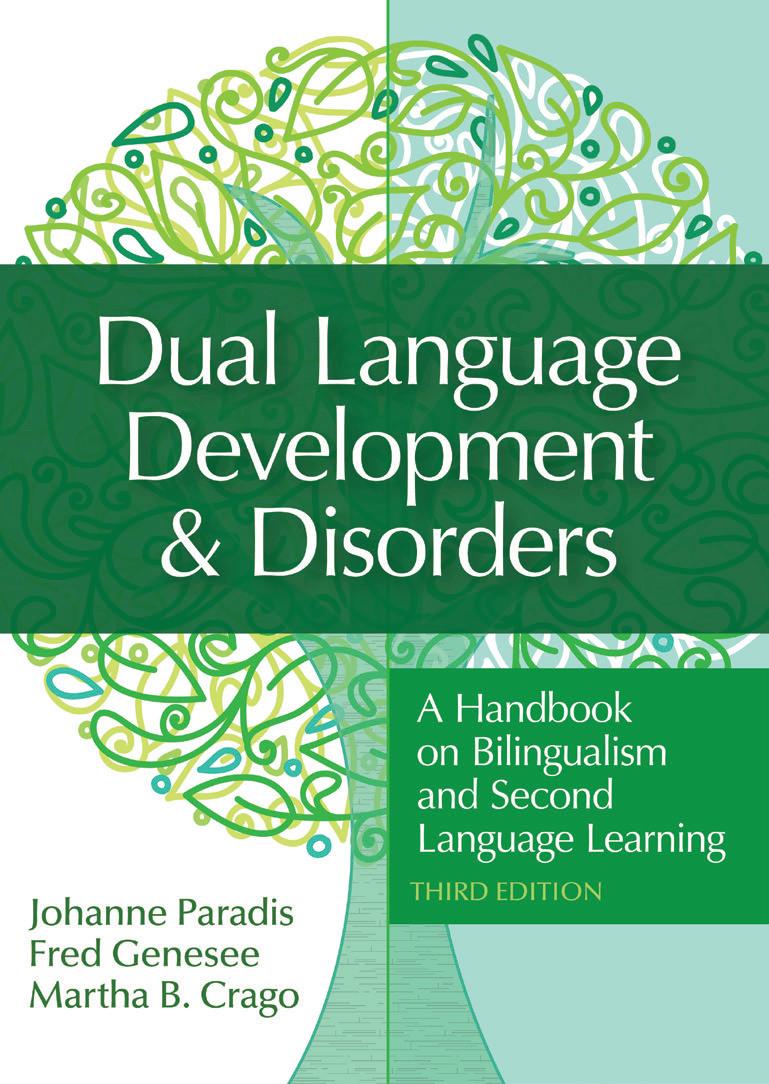
I. FOUNDATIONS
1. Introduction
2. The Language–Culture Connection
3. The Language–Neurocognition Connection
II. UNDERSTANDING BILINGUAL AND SECOND LANGUAGE DEVELOPMENT
4. Language Development in Simultaneous Bilingual Children
5. Code-Mixing in Bilingual Development
6. Second Language Development in Children
7. Heritage Language Development in Children
8. Language Development in InternationallyAdopted Children
9. Schooling in a Second Language
III. DUAL LANGUAGE AND DISORDERS
10. Language and Communication Disorders in Bilingual Children
Appendix: The Normal Curve and Related Concepts
11. Reading Difficulties in Bilingual Children
”An exemplary book that fully captures the state of the field, is well-written for varied audiences, and impactful in its description of findings for practice and policy.”— Sandra Barrueco, Ph.D., The Catholic University of America
Prepare SLPs and educators to support the growing population of dual language learners with the third edition of this bestselling textbook— developed by three influential experts on bilingual language development and aligned with Head Start guidelines on cultural and linguistic responsiveness.
Updated with the latest research and recommended practices, this text gives a broad audience of future professionals the clear and comprehensive information they need to promote positive outcomes for young dual language learners and make informed decisions about assessment and intervention when a disorder is present. Your students will get up-to-date guidance on a wide range of key topics, including recognizing the typical stages of second language learning, supporting development in both languages, distinguishing a language delay from a disorder, planning culturally appropriate interventions, addressing reading disorders in bilingual children, and more. New and enhanced student-friendly features make this edition even more engaging and practical, and a robust new package of online support materials will help faculty members use the book effectively in their courses.
• New chapter on supporting heritage language development in children with immigration backgrounds
• Important updates throughout the book on best practices and recent research findings from the field
• Updated student-friendly features, including learning outcomes at the start of each chapter, tables and figures that illustrate key concepts and research, and Voices from the Field text boxes
• Two downloadable parent questionnaires to help SLPs gather critical information when working with culturally and linguistically diverse children
• New online companion materials: discussion questions and class activities for each chapter, plus a final integrative course project US$49.95 | Stock #: 54067 | 2021 | 400 pages | 7 x 10 | paperback | ISBN 978-1-68125-406-7

As the number of dual language learners (DLLs) in early childhood settings continues to rise, future educators need to know how to teach, engage, and assess children from different cultural and linguistic backgrounds. They’ll have the proven strategies they need with this timely book, a reader-friendly guide that expertly connects research to practice for teachers of young DLLs.
Early childhood educators will start with a detailed review of the demographics of today’s DLLs and the latest research findings on supporting the learning and development of bilingual and multilingual children. Then they’ll find practical, real-world guidance on the best instructional and assessment practices to integrate into their classrooms. Throughout the book, five in-depth case studies of diverse children highlight the importance of considering each child’s background, skills, and home experiences when designing effective learning environments.
• Connect and work with families, with consideration for their cultural context, practices, beliefs, goals, and diverse experiences
• Internalize eight key beliefs every teacher should have about dual language learning and apply those beliefs to practice
• Implement specific, evidence-based classroom practices that promote the learning of young DLLs
• Use best practices to help DLL children develop language and early literacy skills
• Assess the learning of DLLs in culturally valid and linguistically appropriate ways
• Use the results of assessments to inform instruction
Preservice and in-service teachers alike will benefit from the learning objectives, guiding questions, self-study and reflection activities, and downloadable forms, including a case study template for child observations and a helpful resource guide to share with families.
US$39.95 | Stock #: 53848 | 2021 | 200 pages | 7 x 10 | paperback | ISBN 978-1-68125-384-8
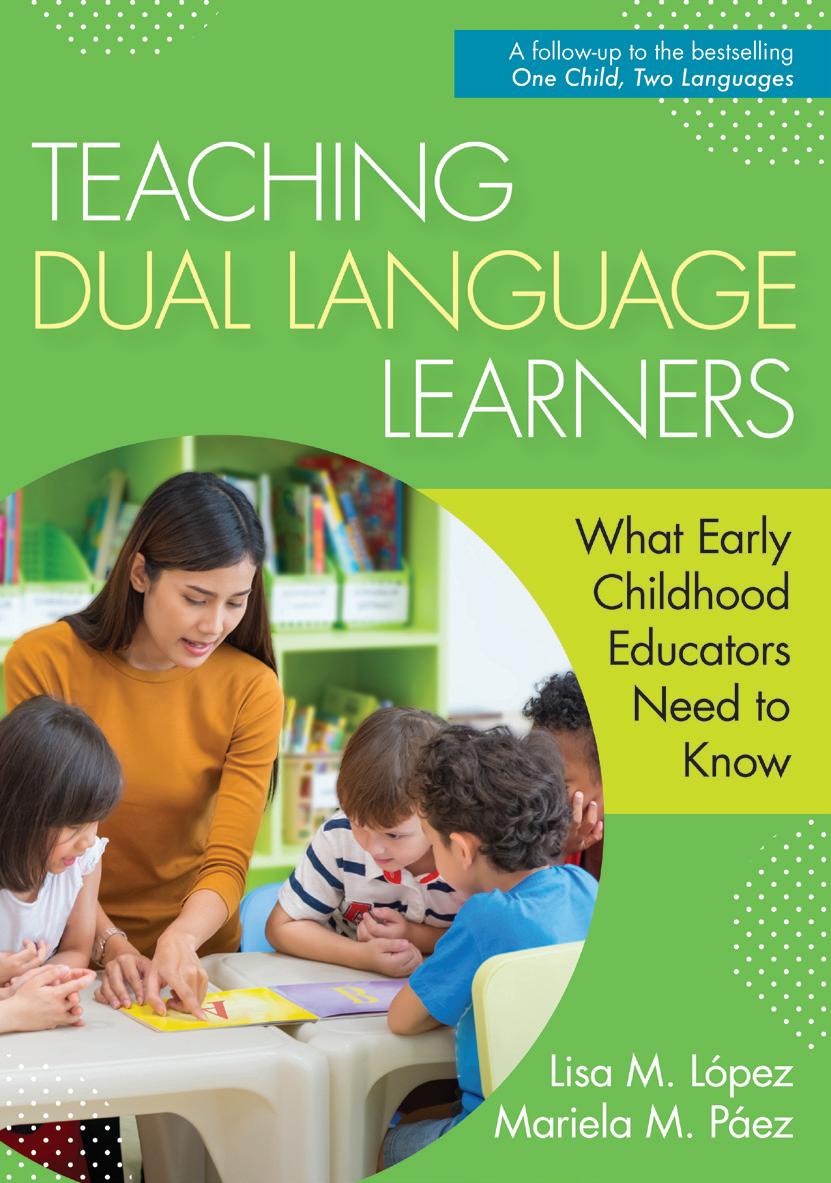
1. Introduction to Dual Language Learners (DLLs)
2. Working With Families
3. Examining Beliefs to Promote Culturally and Linguistically Responsive Practices With DLLs
4. Effective Classroom Practices for Working With DLLs
5. Teaching Language and Early Literacy Skills for DLLs
6. Assessment Considerations and Practices for DLLs
7. Implications for Culturally and Linguistically Responsive Practice


1. An Overview of Home Visiting
2. Collaborating with Families
3. Building Home Visitor: Family Relationships
4. Facilitating Parent‐Child Relationships
5. Structure of Home Visitations
6. Specific Family Challenges
7. Responding to Children’s Challenges
8. Enduring Challenges
9. Personal Concerns of the Home Visitor
For more than a decade, The Art and Practice of Home Visiting has been a go-to guide for effective, culturally sensitive home visits with young children and families. Now reframed as a textbook for a new generation of home visitors, this second edition includes studentfriendly features, downloadable course companion materials, and fresh content on timely topics.
Presenting a collaborative, family-centered approach to home visiting, Cook and Sparks prepare preservice professionals to form respectful and productive partnerships with caregivers and help each unique family reach their specific goals. Future home visitors will get practical, in-depth guidance on all the complex issues they’ll face in their work with families and children, including implementing evidence-based practice; providing trauma-informed care; and addressing challenges with sleep, feeding, and behavior.
A foundational text for future professionals, this book will help all home visitors master the art and practice of effective home visiting with today’s diverse families.
WHAT’S NEW:
• New student-friendly features: Learning Outcomes and ReadReflect-Discuss Questions in each chapter, case studies, chapter summaries, and a glossary
• Expanded focus on all home visitors working with children with and without disabilities
• New and updated content on critical topics, such as resolving barriers to successful home visits and working with culturally, linguistically, and economically diverse families
• Expanded table of contents for easy navigation
• Increased focus on family-centered home visiting and the home visitor as a collaborative coach and partner for the family
• A complete package of downloadable companion materials for faculty
ONLINE COMPANION MATERIALS: Faculty members will easily integrate this book into their courses with the online companion materials, including a sample syllabus, test bank, and PowerPoint outlines.
US$44.95 | Stock #: 54463

As more and more early childhood settings implement inclusive practices, teachers need to blend special and general education techniques to help all children learn. They’ll find out how with the new edition of this bestselling text, which combines today’s best practices for teaching young children with and without disabilities into one comprehensive approach.
Ideal for current and future early childhood educators working with children from ages 2 to 5, this comprehensive text provides explicit guidance on developing a successful curriculum framework, working effectively with families and other team members, tailoring instruction to each child’s individual needs, and embedding learning opportunities that address all children’s goals. Teachers will learn from the field’s most current research, and they’ll get a full continuum of strategies for teaching young children with diverse abilities. Practical information on authentic assessment and data-driven decision-making is also woven throughout the book.
IN THIS EDITION:
• Focus on how to implement multi-tiered systems of support (MTSS)
• New chapters on applying blended practices in specific content areas: language, literacy, social-emotional skills, and math
• The latest on state and federal funding initiatives for early childhood—and how to maintain quality practices that align
• More guidance on determining the scope and sequence of what to teach children
• Current recommendations from key professional organizations like NAEYC and DEC, and their implications for teachers
USER-FRIENDLY FEATURES:
Includes visual aids and sample forms, vignettes and practical examples that illustrate key concepts and guiding principles, helpful summaries for each chapter, case studies, and learning activities that challenge students to test and expand their knowledge.
US$44.95 | Stock #: 76689 | 2017 | 384 pages | 7 x 10 | paperback | ISBN 978-1-59857-668-9
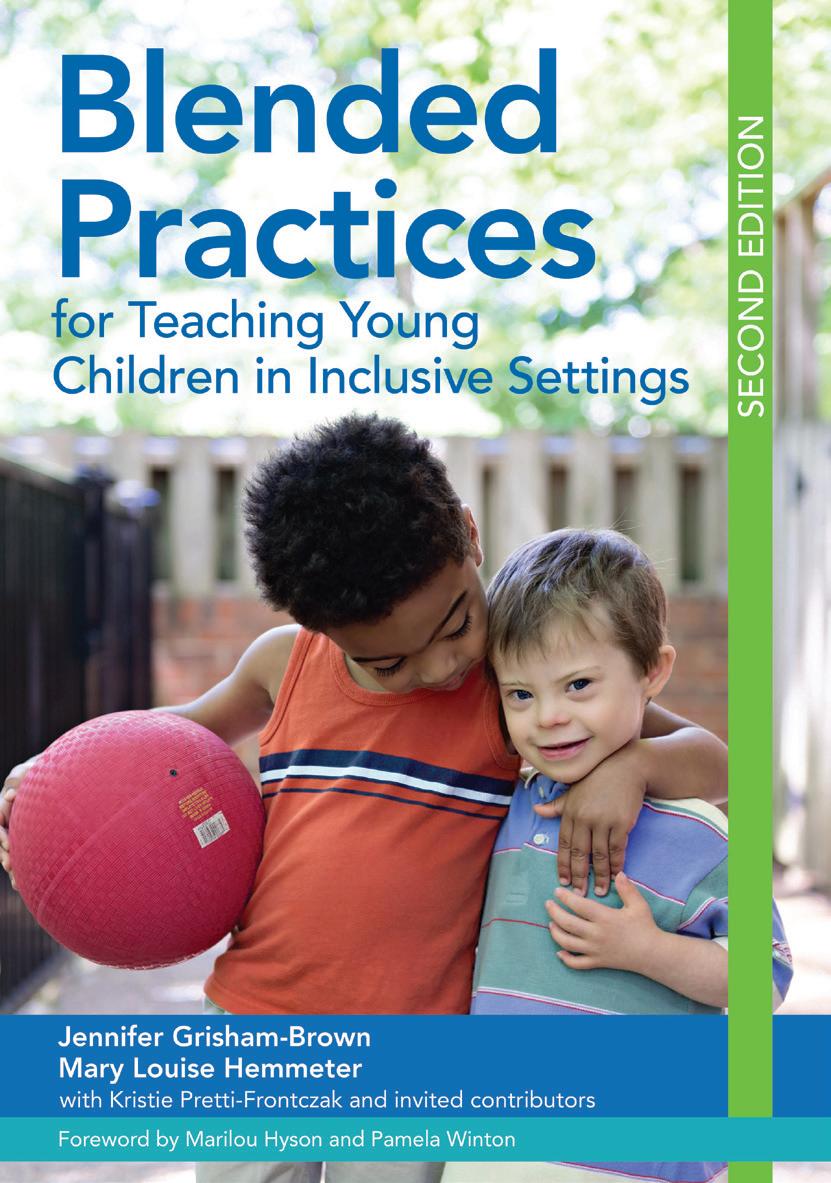
ORDER
I. SETTING THE STAGE FOR BLENDED PRACTICES
1. Introduction to Blended Practices
2. Curriculum Framework as a Model of Blended Practices
3. Identifying Outcomes for Children in Blended Early Childhood Classrooms
4. Recommended Instructional Practices
II. TIERED INSTRUCTION
5. Universal Instructional Practices
6. Focused Instructional Strategies
7. Systematic Instructional Practices
III. SPECIAL CONSIDERATIONS IN THE APPLICATION OF BLENDED PRACTICES
8. The Team Process of Planning, Implementing, and Revising Instruction
9. Blended Practices for Promoting Social-Emotional Development in Young Children
10. Blended Practices for Promoting Literacy Skills
11. Promoting the Language and Literacy Skills of Dual Language Learners
12. Blended Practices for Promoting Early Math Skills

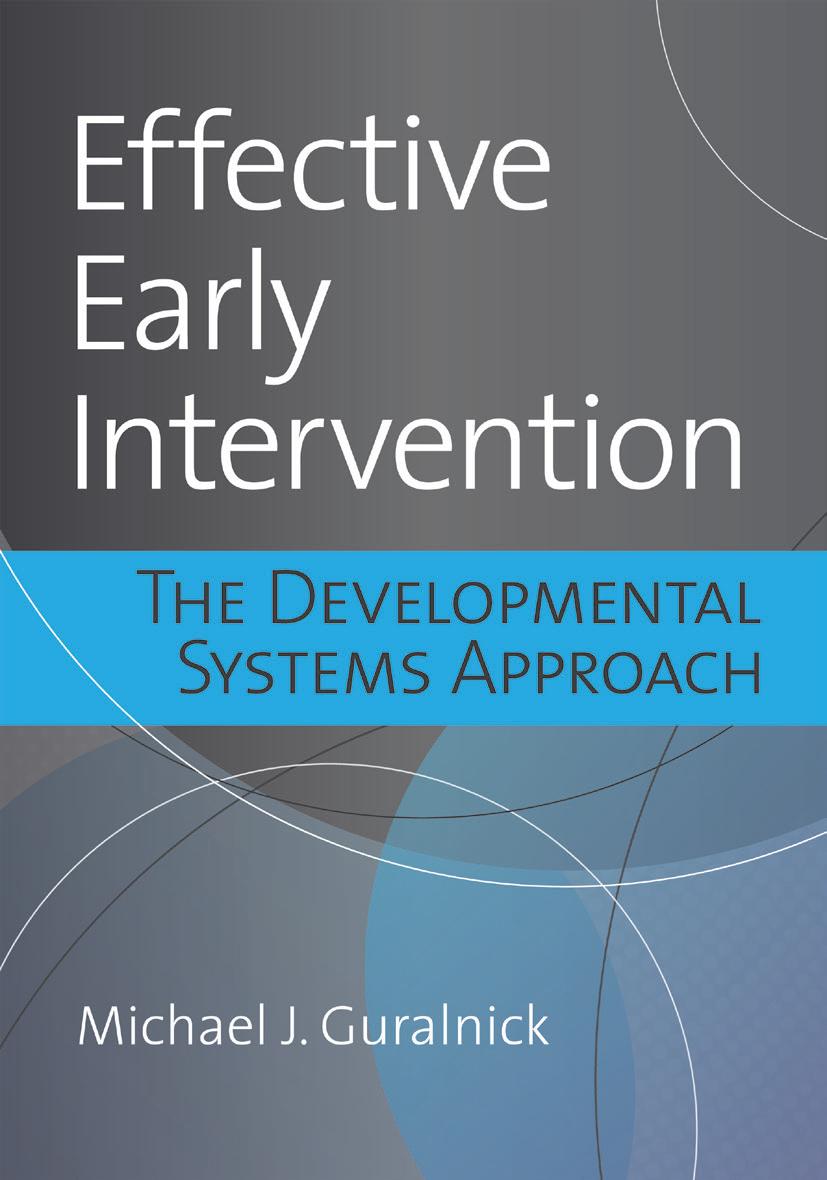
ORDER EXAM COPY
I. INTRODUCTION AND OVERVIEW
1. Foundations of Early Intervention
2. Environmental Influences on Development
3. Early Intervention in the Context of the Developmental Systems Approach
II. CHILDREN AT BIOLOGICAL RISK: PRETERM BIRTH
4. Preterm Birth: Developmental Science
5. Preterm Birth: Intervention Science and Community Systems
III. CHILDREN AT ENVIRONMENTAL RISK
6. Environmental Risk: Developmental Science
7. Environmental Risk: Intervention Science and Community Systems
IV. CHILDREN WITH DEVELOPMENTAL DELAYS
8. Developmental Delay: Developmental Science
9. Developmental Delay: Intervention Science and Community Systems
V. CHILDREN WITH AUTISM SPECTRUM DISORDER
10. Autism Spectrum Disorder: Developmental Science
11. Autism Spectrum Disorder: Intervention Science and Community Systems
VI. APPLYING THE DEVELOPMENTAL SYSTEMS APPROACH TO COMMUNITY PROGRAMS
12. Advancing the System of Early Intervention
In this important text, Guralnick organizes and analyzes the most current research and developments in early intervention through the lens of the DSA. Starting with a clear explanation of the foundations of early intervention, the book then applies the DSA to four vulnerable populations: children at risk due to biological factors, specifically preterm birth, children at environmental risk, children with developmental delays, and children with autism spectrum disorder. Your students will discover how the DSA can guide the development of effective services and supports for diverse young children and families, and they’ll come away with insights on how to use this framework to improve early intervention programs in their own communities. An invaluable textbook for future early childhood researchers, faculty, and policy makers, this forward-thinking book is the key to establishing inclusive community-based early intervention systems that nurture each family’s strengths and promote child development.
YOUR STUDENTS WILL:
• Learn how child development is influenced by three critical family patterns of interaction—parent–child transactions, familyorchestrated child experiences, and parent promotion of child health and safety
After decades of rapid evolution and ground-breaking research, the field of early intervention can be understood within a common framework: the Developmental Systems Approach (DSA). Created by a highly influential leader in the field, Michael Guralnick, this evidencebased, relationship-oriented, family-centered framework focuses on strengthening the quality of key family patterns of interaction that influence a child’s development.
• Understand the developmental science that applies to all children
• Explore the influence of family resources as well as child-specific risk and protective factors on a child’s health and development in the context of early intervention
• Discover ways to select interventions that are most effective for children and families based on intervention science and the DSA conceptual framework
• Learn the fundamentals of applying the DSA framework to designing and implementing inclusive community-based systems of early intervention
US$89.95 | Stock #: 52889 | 2019 | 384 pages | 7 x

Behavior is one of the biggest and most pressing challenges faced by early childhood educators and providers. Find research-based guidance and strategies in this essential textbook for professionals preparing to work with children from birth to 5.
Your students will start with a comprehensive, reader-friendly overview of early growth and learning across developmental domains, with special emphasis on the components of emotional development and the environmental factors that influence it. Then students will learn the guiding principles for nurturing social-emotional development, aligned with the positive behavioral interventions and supports (PBIS) framework and the Pyramid Model. Concrete examples of specific, research-based strategies prepare future professionals to put the principles into action and improve child outcomes in both center- and home-based settings.
A keystone of professional preparation for preservice early childhood providers, this book will help your students work effectively with children, families, and colleagues to foster social-emotional growth in the critical early years.
DISCOVER HOW TO:
• Apply evidence-based universal prevention strategies to proactively support social-emotional growth
• Collect data and use tailored secondary behavior strategies with children who have more intensive challenges
• Collaborate with families and share concerns sensitively
• Overcome roadblocks to PBIS through team communication and consistency
• Encourage mindfulness in yourself and parental caregivers
• Ensure that providers, caregivers, agencies, and other stakeholders work together and share accountability
• Engage in ongoing reflection to improve your self-efficacy and confidence
Sample scenarios that show how to apply strategies, textboxes on collaborating with families, quotes from parents and educators, reflection questions, supplemental exercises, and access to a list of useful web-based resources

I. OVERVIEW: EARLY SOCIAL-EMOTIONAL DEVELOPMENT AND INTERVENTION
1. The Impact of Early Social-Emotional Development
2. Environmental Influences and the Educator’s Role
II: SUPPORTING SOCIAL-EMOTIONAL GROWTH
3. Guiding Principles
4. Strategies Supporting Social-Emotional Growth
III. WE CAN’T DO IT ALONE: ANTICIPATING AND OVERCOMING OBSTACLES
5. Potential Roadblocks to Implementing PBIS
6. Effective Family–Provider Communication
7. Next Steps for Sustaining Healthy Social-Emotional Development


The Brookes Download Hub is your home base for the online course materials— slides, test banks, sample syllabi, and more—that come with Brookes books. Sign up with your faculty email address to download companion materials, “favorite” your books to keep track of your online materials, and get free access to companion materials for ALL Brookes books. Registration is easy—sign up today!
https://downloads.brookespublishing.com
You can request exam/desk copies of up to two books that are relevant to your course needs. If you see a book in this catalog that you’re interested in previewing, please look it up on www.brookespublishing.com, click the Request Exam Copy button found on the book’s page, and complete the request form. (All requested information must be supplied before we can process your order.)



